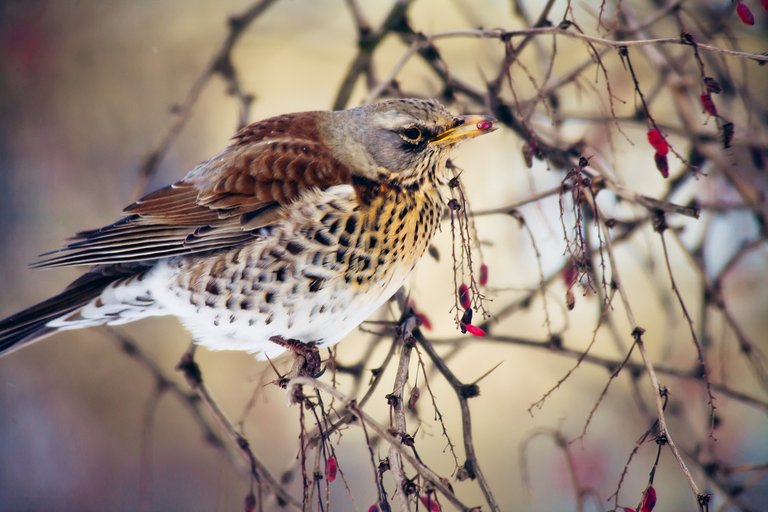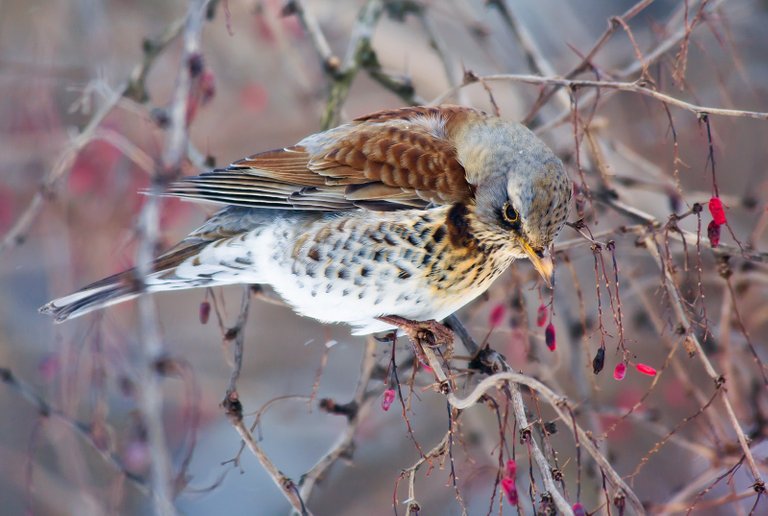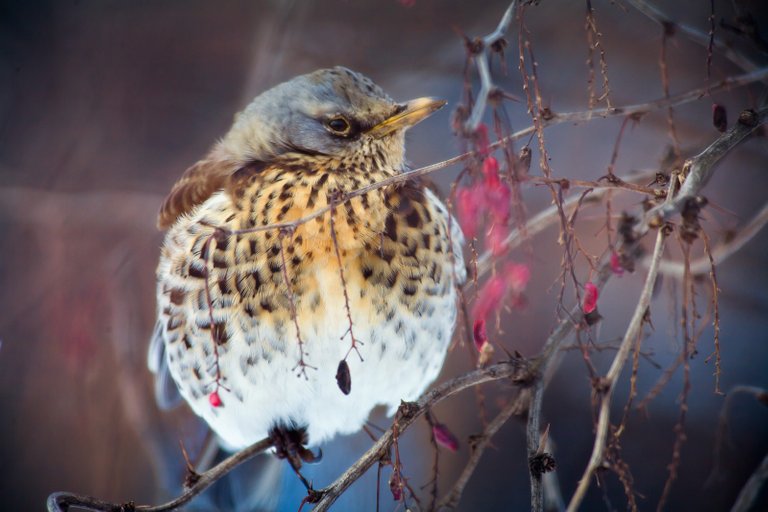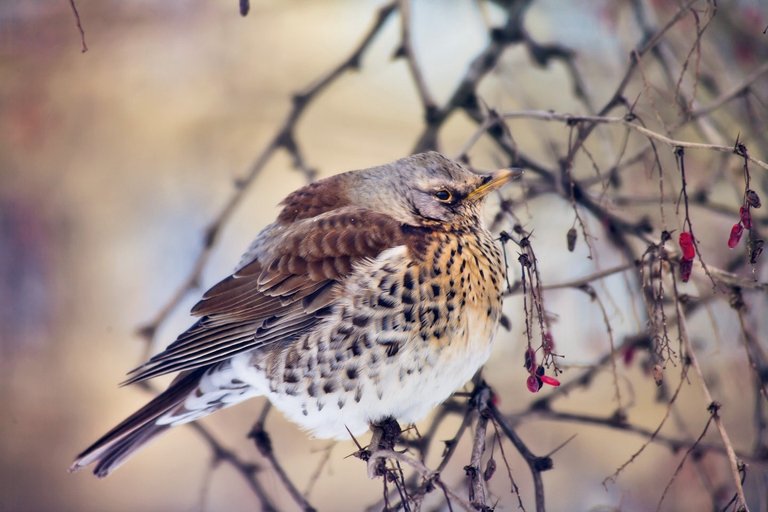DNA species hunt - fieldfare
Turdus pilaris
Classification
The fieldfare (Turdus pilaris) is a member of the thrush family Turdidae.
Classification:
- Kingdom: Animalia
- Phylum: Chordata
- Class: Aves
- Order: Passeriformes
- Family: Turdidae
- Genus: Turdus
- Species: T.pilaris
Common Appearance
You may mismatch Fieldfare with another relative specie - Mistle Thrush (as I did, getting a wrong identification at first - thanks to @dannewton who corrected me!). Theres a number of clues... Check this link to find out what details to look at. Fieldfare are superficially similar to mistle thrush in their general shape and attitude — but again there are distinctive features that make them readily identifiable in most situations.
Appearance:
A large and long-tailed thrush. White belly. Slate grey lower back, rump and head. Brown upper back and yellow to light brown buff breast with black spots. The all dark black tail contrasts with the grey rump.
- Length: 25cm, wingspan: 39-42cm.
- Body: different colours, dark and grey to white, yellow and brown.
- Eyes: Black
- Dominant visible characteristics: spotted yellowish-brown breast.
- Sound: Very vocal. Scolding call a hard "check", often given in decelerating series. Contact call in migration a soft, pleasant and buzzy "weet". Song a mix of dry contact calls; "trrrt trrrrt", and high pitched, drawn out, chattering improvisations. Typically bursts into continuos, squeaky chattering at takeoff.
View from the breast.
Places of Spread
Its main habitats are in the north and middle of Europe and Asia. Some of the birds are sedentary, some are nomadic. Scandinavian fieldfare, like a number of Central European ones, fly to the south for the winter, primarily to the south and west of Europe. It breeds in woodland and scrub in northern Europe and across the Palearctic.
It is strongly migratory, with many northern birds moving south during the winter. It is a very rare breeder in the British Isles, but winters in large numbers in the United Kingdom, Southern Europe, North Africa and the Middle East.
The fieldfare differs from other thrushes by its way of life. Most of the birds gather in medium-sized colonies (up to 30-40 pairs). They prefer parks and forest edges, located closer to meadows. In dense forests, the fieldfare does not occur. It can be seen both in the urban environment and in the forest in the wild. The nesting period lasts from April to July.
Diet
It is omnivorous, eating a wide range of molluscs, insects and earthworms in the summer, and berries, grain and seeds in the winter.
In winter, flocks of fieldfare come to feast on ripe berries (rowan, hawthorn, sea buckthorn, dog rose, holly, yew, juniper, barberry, etc.). If a rowan tree grows nearby, this is a convenient place to track it down to take a photograph. (I never noticed them coming to the hand-made feeder stations). In my case, I found this lonely fieldfare having a dinner at barberry bush.

Fieldfare feeding itself with barberry.
Peculiarities and Rarity
Every winter our resident blackbirds, song thrushes and mistle thrushes are joined by an influx of visiting northern European thrushes: fieldfare and redwing. The birds usually start to arrive from early October, and stay until early March… with some lingering a little later. Also I cant but note that Fieldfare arent shy bids, like tits or magpies -- they let for observer to come at a very close distance. (In my case, I was allowed to come up literally at two steps distance - after that the bird didnt fly away, just moved to another branch, restoring the previous minimum distance). The fact that these birds are not shy is super cool for photography!
Thrushes defend themselves by diving down on enemies and dousing them with shit droppings. People will face massive “shelling” if they come to the colony.
Discovery Statistics
- Date: 2021-02-11.
- Location: St.Petersburg, Russia (GPS 59.9668098, 30.3072215).
This was my 1st encounter with this bird, where I documented it and was able to pay attention to identification.
Information Usage & Copyright Declaration:
The information provided in this post is provided based on my own observations. The pictures used in this post are original and taken by myself, @qwerrie, with a Canon 5D camera. I allow DNA to use the images and the information provided for DNA work within their publicly visible projects.DNA - Densifying Nature-Appreciation




Красавец, смотрится как модель на ветке.
!Engage 20
да, модель. отлично попозировал! не боялся и не улетел, за что ему большое пасибки конечно же. - !BEER и !ENGAGE 15 тоже тебе в холодильник.
ENGAGEtokens.View or trade
BEER.Hey @cranium, here is a little bit of
BEERfrom @qwerrie for you. Enjoy it!Learn how to earn FREE BEER each day by staking your
BEER.@tipu curate :)
thank you, appreciated very much. have a glass of
vodkared !WINE :PCheers @qwerrie, Thank You For Inviting @rozku To A Glass Of WINE.
At The Moment You Don't Have Enough WINE Staked To Order A Glass Of WINE From @wine.bot.
Please Refill Your Barrels By Directly Buying WINE From Marketplace & Make Sure You Have Atleast 25.00 WINE In Staked Wallet.
Total Purchase : 18617.839 WINE & Last Price : 0.280 HIVE
HURRY UP & GET YOUR SPOT IN WINE INITIAL TOKEN OFFERING -ITO-
WINE Current Market Price : 2.500 HIVE
how are you dear friend @qwerrie good afternoon
What a beautiful specimen you present to us. I appreciate all the information about him. Excellent research work
have an excellent afternoon
agree! a nice birdie indeed, looks so pretty! I met it alone on that burberry bush, but usually they attack the bushes in whole flocks, and gnaw them clean :) I suspect there are no such specie in Argentina, but it doesn't matter - you have other wonderful species. long live biodiversity !!
согласен, замечатиельная птичка! мне она встретилась одна, а обычно они налетают на кусты целыми стаями, и обгладывают их дочиста :) подозреваю, в Аргентине таких нет, но это не беда - у вас водятся другие замечательные виды. да здравствует биологическое разнообразие!!
Not this species is not here, but we have some very beautiful birds, now there are few varieties in my background, once spring passes few specimens are seen here.
beautiful the work you have done.
yes, true and correct, I have read this specie do not occure at your country beautiful environment! what can I add to this? it is definitely not a problem, when you want to look at it beauty, you always welcome to enter my post and enjoy its visual. or even better -- enjoy not this one, but the local species, and not in the post, but outdoors. and, uh, we (all the Amazing Nature and DNA team) are looking to your participance in the DNA species hunting program. acquaint us with your local species and their habits and nice features, will you?
no doubt dear friend @qwerrie I am going to prepare a material to present. I really appreciate the invitation
enjoy the rest of the day
We appreciate your work and your post has been manually curated by @nelinoeva on behalf of Amazing Nature Community. Keep up the good work!
A pleasure to have support back. thanks a lot, Neli!
Great capture and very nice writing with a lots of info on this beautiful bird!
Cheers
Denis
thanks -- appreciated!
You gathered interesting information on this bird for the Species Hunt. Great job!